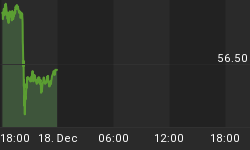For the third day in a row, equity volume was passable, near 800mm shares. That's the best 3-day performance, volume-wise, since early February. What does it mean, on a day that stocks rallied another 0.6%? Bulls will say that it is supportive, showing that the rally is gaining adherents and some of the sidelined cash is returning to the market. Bears will say that it looks like retail is finally chasing the market higher.
I don't know which (if either) of these is true, but either way the market has the support right now of solid, if unspectacular, economic fundamentals. Empire Manufacturing came in at 20.21, Initial Claims fell to 351k, and Philly Fed printed 12.5: all three releases were as good or better than expectations.
Bonds had sold off in the overnight session before rallying back and managing to fall only a smidge, with yields +1bp on the day.
Commodities were generally strong, but the energy sector fell with gasoline off -1.8%. Energy traders were a bit rattled by a Reuters story that the UK and the US had agreed to coordinate releases from strategic stockpiles. Spot Crude dropped $2 instantly. In a way, it is an odd reaction because there are only two reasons to announce a release of reserves now. The first possibility is that it is a political gambit by the Obama Administration to take away a talking point from the Republicans, pushing gasoline prices (ironically, only a week or so after the President said that a plan to lower gasoline prices to $2.50 - proposed by candidate Gingrich - was a 'phony, election year promise.') But if the main point was political, then why involve the UK when any important domestic effect would be driven by a release of US stockpiles?
Possibility two is that a behind-the-scenes discussion on releasing stockpiles in the event of hostilities in the Middle East was taking place. This isn't as much of a stretch to consider as you might think; the current naval deployment map shows that in addition to two aircraft carriers already present in the Gulf region, the U.S. has newly moved a big-deck amphibious warfare ship into the region; also, two other carriers recently put to sea, with one halfway to the Mediterranean already. The Administration's denial of the Reuters story, which caused prices to rebound warily, was also phrased curiously, with White House press secretary Carney saying that "It is inaccurate...that any kind of agreement was reached." "Inaccurate" seems a bit wishy-washy if what he meant was that there were no discussions being had, or that the report was outright false.
If there is any chance of hostilities near-term, of course, it would be stupid to release reserves before shots were fired, because then prices would still spike on news of combat. Any agreement would presumably concern a co-ordinated stockpile release to be announced after fighting commenced. This is not a prediction of war - I am even less qualified to comment on that than on many other things people bash me about. I am simply saying that I am raising my antennae as a result of this curious combination of events.
Any prospective rise in oil prices, as well as the lagged effect of energy price increases which have already happened, is additive to whatever numbers are reported tomorrow in the BLS's CPI report. The consensus estimate is for a rise in headline inflation of 0.4% and 0.2% on core inflation, keeping the year-on-year measure of headline at 2.9% but allowing the year-on-year core reading to slip to 2.2% from 2.3%.
I don't think we will actually get a downtick in core inflation. If core is only 0.17% month/month, then it will be sufficient to sustain the 2.3% year/year print (which was really 2.27%), so to get a downtick to 2.2% you either need 0.15% or 0.16%, or month/month needs to surprise by coming in at only 0.1%. In fact, last February core CPI rose 0.20%, so in order to get an uptick only a +0.27% monthly print is necessary.
It has been 15 consecutive months that we have watched year-on-year core inflation rise, the longest such streak since the mid-1970s. If we get a clean, unrounded 0.2% rise in Core CPI, it should be enough to set a record by edging year-on-year core inflation higher for a sixteenth consecutive month. A downtick is possible tomorrow, but I believe we will set a record.
Record or not, the underlying reasons for being concerned about inflation are just not going away. The latest data on Commercial Bank Credit show that the "wall of money" that was safely in sterile reserves a few months ago continues to leak out. The year-on-year rise in commercial bank credit has finally surpassed 5%, the first time it has returned to the "normal" 5-10% range since the crisis began (See Chart below, source St. Louis Fed).

So if 9%-10% M2 growth, where year-on-year growth in that metric has been for the last 32 weeks, doesn't bother you because of the decline in M2 velocity, the acceleration in commercial credit growth should cause at least a mild discomfort. Yes, banks are healing - and while that is mostly good news, the flip side of healthy banks is recovering money velocity.















